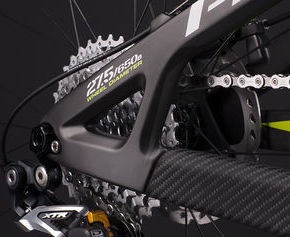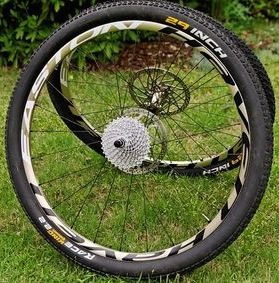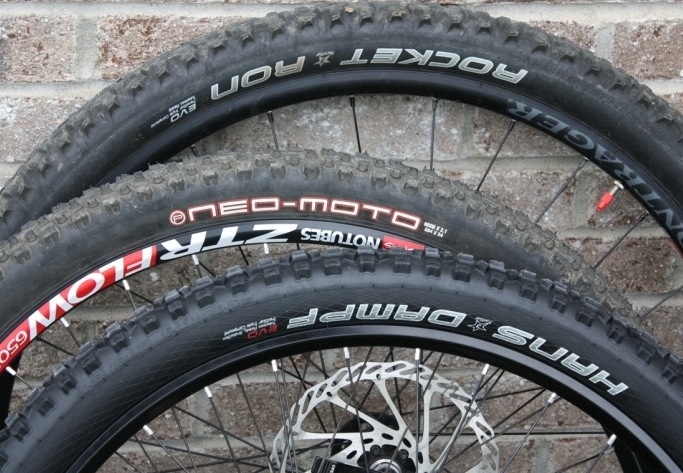In the realm of endurance or marathon mountain bike racing, a game changer of technological advancement has taken hold, seemingly for good. We're talking about big wheels: the new world order of 27.5 inch and 29 inch as opposed to the older generation of 26 inch wheels.
Not so long ago the biggest step forward was the 29 inch wheel offering, amongst other benefits, greater stability and easier, faster riding. But within the past two years companies such as Giant Bikes have rolled out what they again believe to be a better wheel.
Instead of the 29 inch, they've slightly downsized to 27.5. Before we take another step forward, let's just voice a recurring opinion here - brands and riders will fight to the death to explain why their preferred wheel size is the best option. There is NO best option that will suit EVERY style of riding. If you want specific attributes, you choose a specific wheel size.
Assuming you were planning on doing a marathon mountain bike event, what do you think would be the better wheel size for you? Comparing the two 'big wheel' options of 27.5 and 29, it becomes quite a challenging question to answer no matter which way you look at it. The more you think about your answer, the more you realise that it might not make much difference at all when choosing 27.5 inch over 29 inch wheels. It may come down to the bike as a whole when deciding one over the other.
But for the sake of a bit of fun, let's stir the hornets' nest. Blame the author if you blow a blood vessel in your eye, and develop a case of severe rage. Then go ride your bike, it fixes everything!
Related article: "26" vs 27.5" vs 29" wheel tech and knock-on effects"
ARGUMENT FOR 27.5 INCH WHEEL SIZE

Having a 27.5 inch wheel size allows you to benefit from having a larger wheel without losing the benefits of a small wheel. It sounds strange, but this is the most common argument for choosing 27.5. "The best of both worlds" is the general idea here. The marketing hype behind this wheel size is that you receive the added trail clearance, grip, stability and top end speed of a bigger wheel without actually losing the acceleration, manoeuvrability and playfulness of a 26 inch wheel.
ARGUMENT AGAINST 27.5 INCH WHEEL SIZE
You wanted to ride a faster wheel because you enjoy racing marathon or endurance events, but instead of going the whole nine yards and buying a 29 inch bike, you stopped halfway. You opted for a 27.5 inch bike because, well... you wanted a bike as fast as a 29 inch wheel, but as playful as a 26 inch wheel. Sadly, there is no such thing. There will be no tail whips halfway through your 6 Hour mountain bike race. Your bike might be capable, but is it designed for this, and is that why you bought it?
CONCLUSION
A 27.5 inch wheel is suited to a broad range of riding terrain, so caging the wheel into one style of riding is like taking a Peregrine Falcon and putting it in an aviary. It looks out of place, and would probably be better suited to more expressive freedom, such as enduro, trail, freestyle or even more gravity fuelled riding. But in relation to cross country riding as one specific style, this wheel size doesn't seem to be gaining the traction it anticipated in the endurance mountain biking world. Apologies for the horrendous pun, it had to be said.
Riding scenes such as enduro (not endurance) are loving this wheel size, due to it's versatility in gravity racing.
ARGUMENT FOR 29 INCH WHEEL SIZE

In the interests of riding faster on tracks that require you to pedal the bike you might opt for a 29 inch bike. Not only will you truly benefit from a more stable bike, but you'll now also clear obstacles with a little more ease. You'll also be able to ride at a much higher speed on the open trail and maintain that speed with ease! The usual perks of added traction, wider tyres and a smoother ride are also included free of charge.
ARGUMENT AGAINST A 29 INCH WHEEL SIZE
Although 29 inch wheels do offer a higher top end speed they also tend to feel a little sluggish through corners. This is partly due to a longer wheelbase as well as a slightly higher centre of gravity. The same applies to overly technical terrain, with a few riders complaining of slow handling and and awkward feel about the bike when traversing rock gardens or twisty trails.
CONCLUSION
If you want to maximise your input into the bike, opt for a 29 inch wheel size to suit your racing needs. The bigger wheels and ever so stretched wheelbase do offer a much more stable feel at speed, with the bike rolling over insignificant bumps with ease. However, if you intend racing on trails with absolutely no straight sections, littered with obstacles and mostly uphill, then this wheel size isn't ideal. The 29 inch wheel size is extremely popular in marathon and cross country circles and this fact cannot be ignored. The wheel size is perfectly suited to the varied terrain you'd encounter on an XC trail, although admittedly you won't see too many enduro or downhill riders flaunting these oversized hoops.
The general consensus is that you would be best riding a 29 inch wheel size for endurance riding. The top speed, precise handling at speed, and versatility in overcoming rough terrain are all winning cards on this wheel size.
However if you aren't able to categorise your own riding style, then don't categorise your bike. For example when riding greatly varied terrain, you could consider a mid-sized 27.5 inch wheel, and while you're at it - make it a dual suspension bike to greatly increase the versatility.
Which side of the fence are you on?



